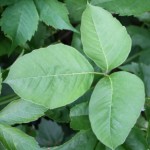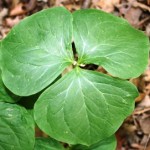It can be very helpful to know the visual identify of certain plants while enjoying a woodland area. For example, the leaves of Large-leaved Aster (Eurybia macrophylla) may be used as emergency toilet paper. But woe to those who confuse this aster with poison ivy . . . talk about your pain in the butt!
If you encounter poison ivy in Minnesota it will likely be Western poison ivy (Toxicodendron rydbergil). This species of poison ivy may grow to knee height. Leaf length is approximately 3-4” by a width of about 2” and varying subject to growing conditions. The plant will always have three leaflets, thus the saying “leaves of three – flee from thee” or “leaves of three – let it be”. When any part of the plant is broken or bruised it releases toxic oil, an irritant to human skin. This oily residue is very long lasting so it’s a good idea to wash any clothing, gloves, tools, etc. that have been exposed.
Poison ivy is a native plant to Minnesota and animal species do eat the fruit and leaves. However, because poison ivy may be harmful to humans in varying degrees, the Minnesota Department of Agriculture (“MDA”) has placed poison ivy on the Specially Regulated Plants list. The following statement is posted on the MDA website and is applicable to poison ivy:
Must be eradicated or controlled for public safety along rights-of-ways, trails, public accesses, business properties open to the public or on parts of lands where public access for business or commerce is granted. Must also be eradicated or controlled along property boarders when requested by adjoining landowners.
As a visual leaner, it always helps me to “see” what I am studying. For those who share my visual learning style, here is the “seeing” portion (i.e. photos).
Trillium (copyright 2012 Landscape Restoration, Inc.)
Note the defining characteristic of the terminal leaflet on poison ivy – a short stem seperating it from the other leaves. In contrast, all three leaves of Jack-in-the-pulpit and Trillium are directly attached to each other at the center.
Don’t let a limited risk of exposure to poison ivy hinder your enjoyment of the woods, especially now that you understand what poison ivy looks like. Nature provides an amazing array of flora and fauna. The best way to enjoy, appreciate and learn about nature is up close and personal. Step away from your screen and go outside.
Cheryl Jirik
Landscape Restoration, Inc.





